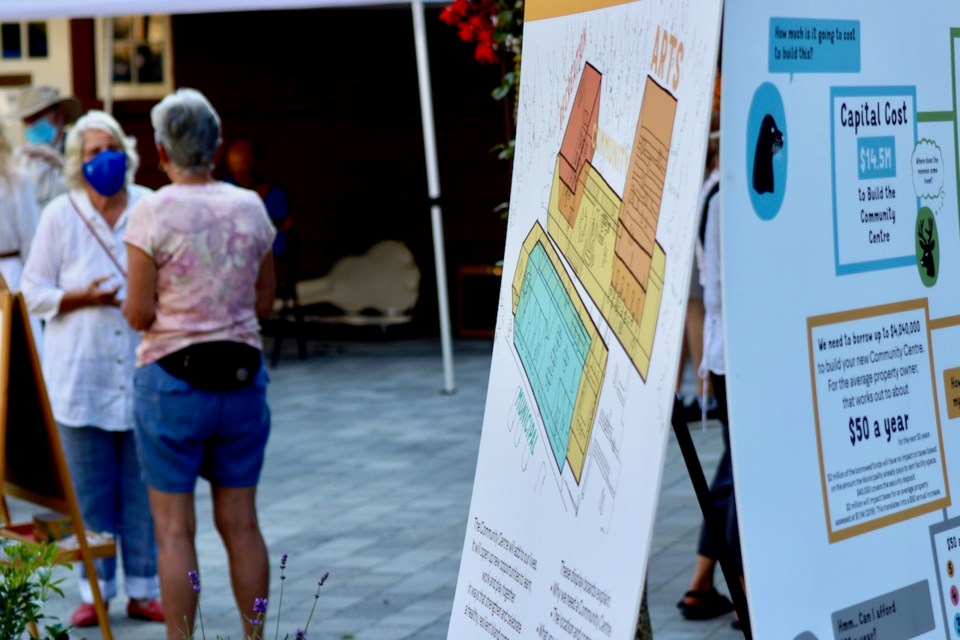The tax bill is one of the public sticking points for the community centre project: Bowen Island Municipality estimates, with capital and operational costs, a four per cent tax rise.
Borrowing
The muni is asking to borrow up to $4 million but only half of the loan is to affect the tax bill. By redirecting money it pays in rent (municipal hall rent is $105,000 a year), BIM can cover half of the annual debt payment of $210,000 (at a two per cent interest rate). This is over a 30-year term.
The half of the debt payment not covered by redirected rent money would result in a two per cent rise in taxes––the oft-quoted $50 per year for the average Bowen home assessed at $1,086,700.
But, municipalities borrow from the Municipal Finance Authority. Loans for capital projects usually have fixed rates for 10-year intervals, BIM’s chief financial officer Raj Hayre noted at the most recent Finance Advisory Committee meeting. The current rate for 10-year loans with the finance authority is 1.56 per cent (rather than the two per cent used in calculations).
Municipalities can borrow up to 25 per cent of their annual revenue, BIM’s chief financial officer Hayre told the Finance Advisory Committee (put another way, the debt payments can’t exceed 25 per cent of BIM’s annual revenue). This means that BIM has the capacity to borrow up to $46 million said Hayre.
When it comes to debt, BIM borrowed $2 million for the Community Lands in 2005 (debt servicing for which is tax funded) and $2.5 million for the Cove Bay Water Treatment Plant in 2019 (which is user fee funded). The municipality is approved to borrow a further $3 million for the yet-to-come fire hall (tax funded). Should the community centre referendum pass, BIM would be set to borrow up to $11, 573,000––a quarter of what it could (with elector consent).
“That is a prudent amount of borrowing for a community this size - many communities are far above this amount,” said Hayre in his staff report.
Building
The project itself has a $2 million contingency, but the business plan puts the cost risk at medium––increased due to the pandemic and an unknown economic market. A funding shortfall would require further fundraising said the business plan.
Of note here, is that BIM’s largest capital project to date, the $7.6 million water treatment plant currently under construction is on time, on budget and on scope according to BIM’s chief administrative officer, Liam Edwards.
Operating
If the community centre is built, BIM estimates its operating costs to require a further two per cent rise in taxes (or $47 per average household).
Unanticipated operating costs would be funded through taxation revenue said the business plan. Maintenance and replacement costs are to be addressed in capital renewal and replacement.
When asked about BIM staying on operating budget, Edwards said, “I think it’s pretty common for the operating budgets [on a project like this] to move up or down, depending on what happens.”
While the community has a strong mandate to ensure recreation services are paying for themselves, community centres don’t tend to be financially independent, stressed Edwards. “The very nature of the facility is to provide services to the entire public to make it accessible to all,” he said. “So that we’re able to provide programming and services to all residents of the island.”
Edwards said that BIM isn’t trying to compete with the more “premium services” on the island––like the two other gyms.
Opposition
Deep Bay homeowner Gordon Reid is concerned with the number of capital works projects and their ongoing associated yearly expenditures. “A lot of these projects seem to be okay individually, but when you put them all together they start to get a little bit overwhelming,” he said.
But Reid is most concerned with the growing tax burden for a small tax base that has seen rises of between six and eight per cent the past few years (except in 2020 due to COVID-19) before parcel and other authorities’ taxes.
“We don’t need to fill in our ditches and we don’t need sidewalks everywhere. We don’t need streetlights. We don’t need a lot of things because we can’t afford it,” said Reid.
“The tax base is not increasing at the same rate as government expenditures. The municipality needs to look at alternate sources of income rather than just property tax, as other municipalities do.”



